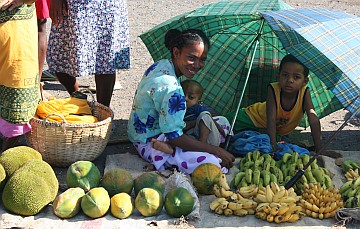
Fruit seller at the port of Ankify, mainland
Inland Madagascar
30 October 2007, Mahajamba Bay, Madagascar
 Fruit seller at the port of Ankify, mainland |
Dear Friends and Family,
We left you with Ocelot sitting in Crater Bay (13°24'S 48°13'E) being watched by locals working for the man whose yacht we rescued off the rocks. We took an early morning "high-speed" ferry (actually just an open boat with a 115 horsepower outboard and 12 people in life-jackets) from Nosy Be island to the mainland, a trip of about 45 minutes. There we watched the colorful market scene around us while we waited for our nice purple mini-bus that would take us inland.
Traveling in Madagascar is ... different. Only the 'main highway' that runs down the length of the island is paved, so we had an hour or so of dusty pot-holes to bounce through before getting there. But even then, 'highway' is a poor term. The roadway is only about 15' (4.5m) wide total, so the average 8' (2.4m) wide truck can often take more than his half. Bridges are all much narrower single-lane affairs, requiring that all vehicles slow down and aim very precisely. Even though the road is nominally paved, there are still large pot-holes every few miles, requiring constant attention and good brakes.
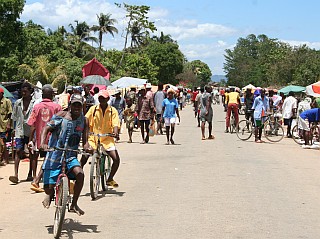 Busy town on the main road of N. Madagascar |
The countryside is mostly dry and arid, which we were not expecting. Somehow, Madagascar has always conjured up images of tropical rain-forests, and we did see some, but not as many as we expected. Dirt-poor only begins to describe most of the inhabitants. The vast majority of houses we see are constructed of sticks and palm fronds. We passed dozens of villages of 100‑400 houses, with no running water, no electricity, perhaps a few portable generators and only 1‑2 vehicles in the entire village. Lots of small piles of tomatoes or mangoes out front to sell to passersby. The people seem happy and friendly, and many speak passable French but no English. They're all darkly colored and obviously African, but their physical features show lots of Malay and Arab and some Indian characteristics as well.
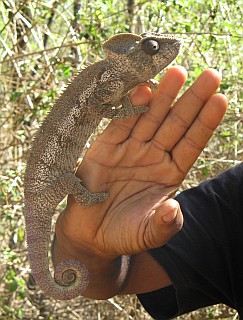 Goulam holds up a lovely chameleon |
Our first stop was at the only real town we passed all day. People crowded the streets on foot and bicycle. Vendors sat on plastic bags or blankets with their piles of fruit. All seemed colorful and bustling. We were directed to a small thatched hut for lunch. In the tiny dark room (maybe 12x20 feet or 4x6 meters) were 5 fly-covered rough wooden tables. A lovely young woman dished up rice and steaming chicken from big aluminum vats on a platform by the back (and only) window. Peeking out the back door we could see the kitchen: a dirt yard with a couple pots over an open fire. A quick glance along the road told us this was most likely the best place to eat. Bravely, we dug in. Amanda and Sue drank bottled water while Jon bought a beer from the neighboring vendor. (We're happy to report no undue effects!)
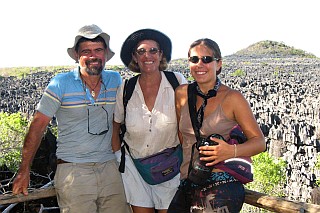 On the edge of Tsingy Rary, a field of karst |
Our destination was Ankarana Nature Preserve, a few hours north. We arrived in the early afternoon, just in time to put our gear in a rustic (but lockable) hut before heading out on a nature walk with the owner. Eugene Goulam has studied the flora, fauna, and interesting karst limestone formations extensively. Goulam was wonderful! He speaks fluent English and French, knows all the animals and has an eye that can spot a chameleon when nobody else can. He showed us lots of geckos, chameleons, and lemurs as we strolled deeper into the park, and he even knew the Latin names for them. The area has some volcanic outcroppings but it's predominantly old limestone, much of which has weathered over millions of years, creating fields of sharply pointed karst, which the locals call Tsingy (Malagasy for "walk on tip-toe"). There are also lots of caves and we explored some of them, somewhat to the annoyance of all the bats that live there. Before going back to the guest lodge, Goulam had us wait until dark so he could show us some of the nocturnal animals, spotted by seeing their eyes reflect a flashlight beam back. Very cool.
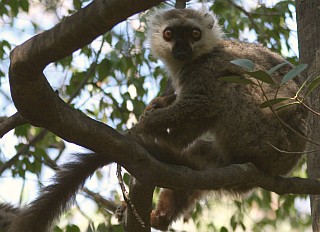 A Sanford Lemur peeks out of the trees |
Goulam Lodge is still getting started (showers are of the bucket method) but the food is good, plentiful and wholesome (roast chicken and garlic over noodles that night). It's also right near the main road, allowing travelers on public transportation (like us) to get there easily. There's lots of camaraderie between the guests in the evenings, discussing what we saw, asking questions of Goulam, and listening to his stories.
The next morning Goulam got us up at 5am for a quick continental breakfast before we headed out on what ended up being a 22km (13 mile!) hike. We carried 6 liters of water and used it all. Blistered feet aside, it was an awesome day through cool forest, roasting hot tsingy, viewpoints over a sacred emerald lake, many lemur sightings and making close friends with chameleons, geckos, and a small snake. Goulam was our guide again, reassuring us that Madagascar had sent all the poisonous reptiles and insects to Africa long ago!
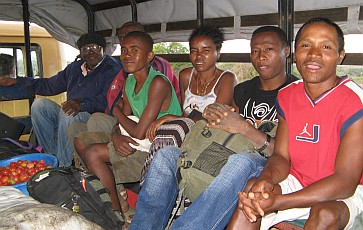 Fellow passengers on the taxi brousse |
Anxious to hold to our plan of seeing more of northern Madagascar, we hopped aboard a "taxi-brousse" (jungle taxi) which in this case was a 10 ton Bedford truck with bench seats and huge bags of mangoes, live chickens, and all sorts of other things on the floor. Jon sat in front and reported later that we almost hit 30 mph (50 kph) once. The potholes are real back-breakers when riding on the bench seats. Sue and Amanda had nice conversations and laughter with folks in the back, but it got quite chilly when the sun went down. It took us 4 hours to go 60 miles (100 km) arriving in the town of Diego Suarez (NE corner of Madagascar) well after dark. One of the passengers, a guide who has worked with Goulam for 3 years, was nice enough to walk us to a delightful small hotel where we collapsed under mosquito nets after washing off the layers of road dust and enjoying a nice meal at a neighboring restaurant.
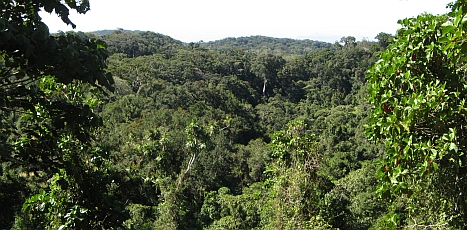 Lush rainforest covers Mont d'Ambre National Park in N. Madagascar |
We slept in a bit the next day, then arranged a ride to Montagne d'Ambre National Park - one of the few remaining stretches of rainforest in northern Madagascar. We walked with a guide on soft forest trails until dusk, seeing more birds and a few lemurs, plus the world's smallest chameleon - just an inch long! It wasn't the wildlife treat Ankarana was, but it was much cooler - so nice to be high up under the big lush rosewood, ebony and ficus trees hung with orchids and other epiphytes. We had a delightful picnic lunch overlooking a small lake, and later visited a couple of nice waterfalls.
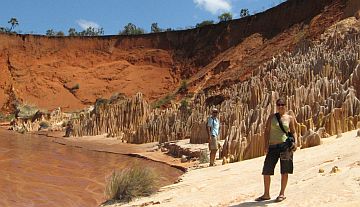 Jon and Amanda in the hot, beautiful Tsingy Rouge |
Our final morning in the northern tip of Madagascar we hired a 4WD and driver to take us SE, early in the morning, to see the Tsingy-Rouge (Red Tsingy). These turned out to be sand formations overlaid by red clay long ago. Erosion has worn the clay away, exposing the tall white (with tinges of red) columns of sand formations underneath. For those who've been to Bryce Canyon National Park, it's similar (though much smaller).
Our trip back to Ocelot was fairly straight forward. Our driver dropped us off at the airport and eventually a 737 arrived to take us away. No assigned seats, X-rays, or even baggage inspection. They didn't even check to make sure we got on the right plane (there were 4 to choose from). They gave us candies to suck on when we descended to help us pop our ears (haven't seen that since the 1950s!). Ocelot was fine when we got back, and it was nice to sleep in our own beds again.
Fair winds and calm seas -- Jon, Sue and Amanda Hacking
Top Level: Home | Destinations | Cruising Info | Underwater | Boat Guests | Ocelot | Sue | Jon | Amanda | Chris | Site Map | Make a Comment
|
If our information is useful, you can help by making a donation |
Copyright © 2000‑ Contact: Jon and Sue Hacking -- HackingFamily.com, svOcelot.com. All rights reserved.